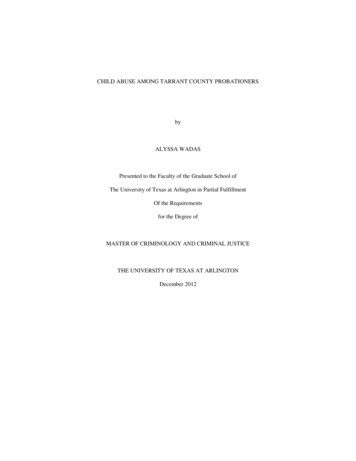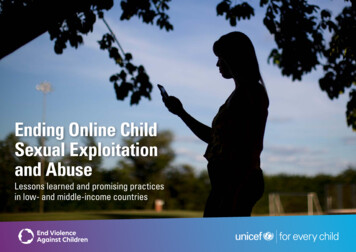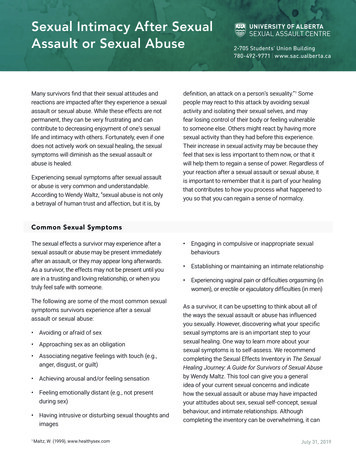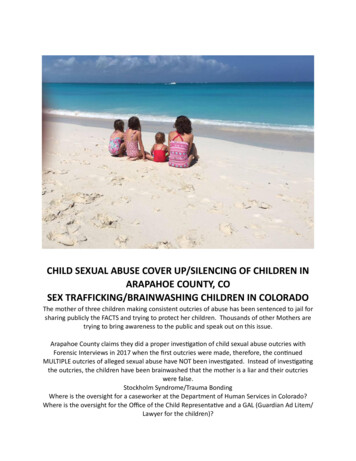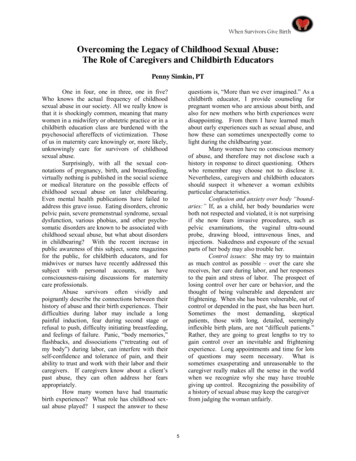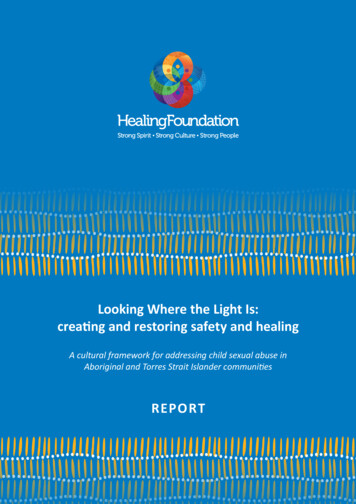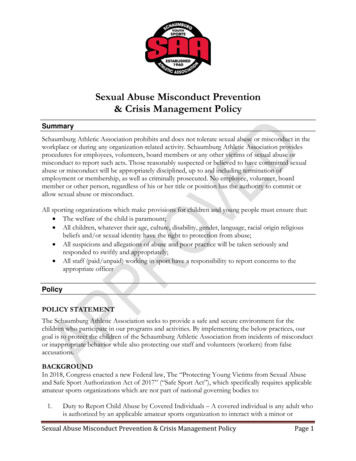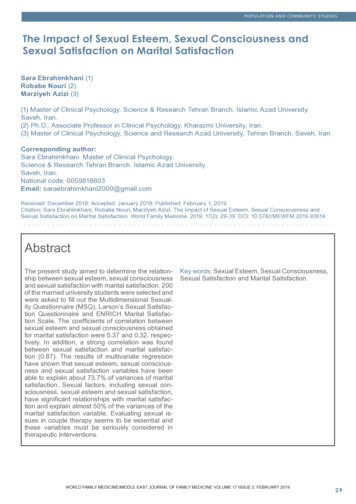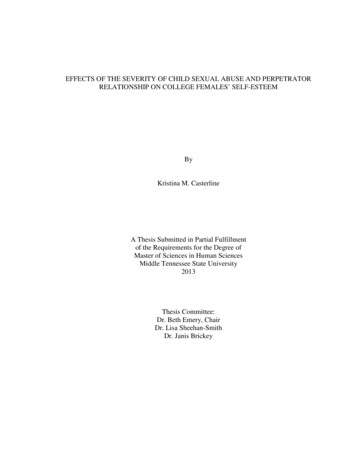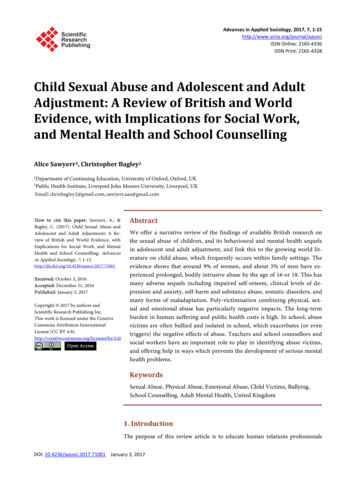
Transcription
Advances in Applied Sociology, 2017, 7, 1-15http://www.scirp.org/journal/aasociISSN Online: 2165-4336ISSN Print: 2165-4328Child Sexual Abuse and Adolescent and AdultAdjustment: A Review of British and WorldEvidence, with Implications for Social Work,and Mental Health and School CounsellingAlice Sawyerr1, Christopher Bagley212Department of Continuing Education, University of Oxford, Oxford, UKPublic Health Institute, Liverpool John Moores University, Liverpool, UKHow to cite this paper: Sawyerr, A., &Bagley, C. (2017). Child Sexual Abuse andAdolescent and Adult Adjustment: A Review of British and World Evidence, withImplications for Social Work, and MentalHealth and School Counselling. Advancesin Applied Sociology, 7, ceived: October 3, 2016Accepted: December 31, 2016Published: January 3, 2017Copyright 2017 by authors andScientific Research Publishing Inc.This work is licensed under the CreativeCommons Attribution InternationalLicense (CC BY en AccessAbstractWe offer a narrative review of the findings of available British research onthe sexual abuse of children, and its behavioural and mental health sequelsin adolescent and adult adjustment, and link this to the growing world literature on child abuse, which frequently occurs within family settings. Theevidence shows that around 9% of women, and about 3% of men have experienced prolonged, bodily intrusive abuse by the age of 16 or 18. This hasmany adverse sequels including impaired self-esteem, clinical levels of depression and anxiety, self-harm and substance abuse, somatic disorders, andmany forms of maladaptation. Poly-victimisation combining physical, sexual and emotional abuse has particularly negative impacts. The long-termburden in human suffering and public health costs is high. In school, abusevictims are often bullied and isolated in school, which exacerbates (or eventriggers) the negative effects of abuse. Teachers and school counsellors andsocial workers have an important role to play in identifying abuse victims,and offering help in ways which prevents the development of serious mentalhealth problems.KeywordsSexual Abuse, Physical Abuse, Emotional Abuse, Child Victims, Bullying,School Counselling, Adult Mental Health, United Kingdom1. IntroductionThe purpose of this review article is to educate human relations professionalsDOI: 10.4236/aasoci.2017.71001January 3, 2017
A. Sawyerr, C. Bagley(particularly in Britain, where we are educators and mental health professionals),concerning recent and very important work on the long-term mental health sequels of child sexual (and other) abuse. These studies have profound implications for how secondary school teachers, counsellors and social workers shouldorganise their work, and relate to pupils and clients. We stress that this is not asystematic meta-analysis, but the development of an argument based on published research in one European country, in understanding the implications ofthese findings for professional education and policy planning. Our approach isbased on child-centred, critical realism. Critical realism is usefully defined byBryman (2016) as “ A realist epistemology that asserts that the study of the social world should be concerned with the identification of the structures thatgenerate the world. Critical realism is ‘critical’ because its practitioners aim toidentify structures in order to change them, so that inequalities and injusticesmay be counteracted” (Bryman, 2016: p. 690). Thus from the outset we start withthe value presumption that child sexual abuse is not only a hidden crime, but itis also morally wrong, and is embedded in the implicit values of sexist socialstructures. Our research and teaching is not value free, but seeks to engage in active, morphogenetic social change (Archer, 2014).Our opinion, as professional educators, is that front-line practitionersshould be fully conversant with clinical, forensic and epidemiological researchwhich has implications for their practice, and for this reason we had earlierproduced systematic summaries of the North America research and clinical literature for practitioners (Bagley & Thurston, 1996). The bulk of the work reviewed here is British, but we link these studies to relevant findings from othercultures, which have particular significance in interpreting and evaluating theseBritish findings.1.1. Earlier British Research on Forms of Child Abuse, ItsIncidence and Its Long-Term EffectsCompared with North America (Finkelhor, 1979), the British literature on childmaltreatment is fairly recent. But the published work from Britain is of goodquality, and offers several avenues for further research and intervention. Thefirst located study is that of Baker & Duncan (1985) who reported findings froma brief question about any kind of unwanted sexual contact in childhood, in anational random sample of 2019 individuals: 12 per cent of women, and 8 percent of men recalled such abusive events, but no further details were available onthe nature of the abuse. The next study of note comes from Scotland (Gillham etal., 1998). This research team examined a large data set of referrals for childmaltreatment (physical abuse and neglect, and sexual abuse) in Glasgow in theearly-1990s, measured against a backdrop of a sudden rise in unemployment.They found a clear link between a rise in abuse referrals, and a rise in unemployment, especially in traditionally low-income areas. This “sub-cultural” effect, in deprived urban areas, also emerged in the English work of Coid et al.(2001) who in research with 1207 women registered with GPs in London, found2
A. Sawyerr, C. Bagleythat those who in childhood had experienced combinations of physical and sexual abuse, were four times more likely than other women of similar age and social class, to have been subject as adults, to domestic violence, and rape in various settings.In contrast, Oaksford & Frude (2001) studied 213 English female undergraduates using questionnaires, and found that 28 (13%) had experienced varioustypes of sexual abuse in their childhood or teenage years. They comment on thegenerally good mental health of this group, and the fact that they were successfully coping with tertiary education. This and other research shows that therecan be “survivors” of even the grossest forms of abuse, provided that it is notcombined with other forms of abuse. Thus in the large-scale follow-up of a largecohort identified child victims of child sexual abuse-CSA (probably combinedwith other forms of abuse) in Britain, had diagnosable psychiatric disorderswhich were more than four times the rate in individually matched, non-abusedcontrols (Spataro et al., 2004).One disturbing feature of children and adolescents experiencing chronicchaos at home-witnessing family violence, substance abuse, and the physical andsexual assaults of others, and experiencing such assaults themselves-was that ofrunning from home (Meltzer et al., 2012). These researchers examined thelife-histories of a subsample of 2247 individuals in the English Psychiatric Morbidity Survey, and reported that seven percent of this group had run from homebefore the age of 16—the rate in girls was double that in boys. In this populationof runaways, 45 percent had been physically maltreated prior to running, 25 percent witnessed frequent family violence, and nine percent were subjected to sexual penetration. After running, both males and females were at high risk for suicidal behaviour, and of being drawn into the worlds of commercial sex, drug use,and drug-dealing.1.2. The NSPCC StudiesThe work commissioned by the English NSPCC (National Society for the Prevention of Cruelty to Children) between 1998 and 2009 provides the most comprehensive available studies on the prevalence of child maltreatment, and the social contexts in which it takes place (Radford et al., 2011; Radford, 2013; Radfordet al., 2013). The first NSPCC survey was of a large random sample in 1998, ofBritish adults aged 18 - 24. The second survey in 2009 was more ambitious andasked questions about prior events of abuse not only of young adults, but also ofthe parents and caretakers of some 4000 children.The comparison of the young adult samples of 1998 and 2008-9 is instructive,since the same set of questions applied to large random samples of the Britishpopulation at both points in time, clearly showed that the prevalence of variousforms of physical abuse, physical and emotional neglect and sexual violence wasdeclining, and this welcome movement was clear statistically significant. We reproduce some of these results below:3
A. Sawyerr, C. BagleyAny physical violenceAny coercive sexual s13.1%9.0%9.9%8.5%“Middle class”11.5%9.0%5.7%4.3%“Working class”18.2%13.1%10.2%7.2%2-parent family10.2%7.9%5.3%3.2%1-parent or in care15.7%15.7%12.7%9.7%Source of data in above table: Radford et al. (2011).This research shows that there is indeed a class bias in the experience ofphysical and sexual abuse, which also occurs with greater frequency in disorganized family settings. The small but statistically significant decline in the amountof sexual abuse might be due to greater media publicity about high-profile abusers (children knowing more about, and being able to avoid CSA), and greaterawareness of teachers and other professionals, as well as the introduction ofrelevant teaching in schools about avoiding CSA. But that is speculation, anddifficult to prove. Lorraine Radford and her team included a number of mentalhealth measures in the 2009 survey of young adults, and reported, for example, asix-fold increase in suicidal ideas and self-harm in prior victims of CSA: “Therewere strong associations between maltreatment, sexual abuse and physical violence with poorer emotional well-being, including self-harm and suicidalthoughts, demonstrating the need for prevention and earlier intervention toprotect young people from harm” (p. 122).1.3. “Poly-Victims” and the Possibility of Enduring NeurologicalChanges Caused by Child MaltreatmentThe idea of children being victims of multiple types of abuse, and as a result areat much greater risk of adverse mental health problems was identified in the review by Finkelhor et al. (2007) of mainly American research, and he coined theterm poly-victimization. This idea had also been developed by Bagley & Mallick(2000a & 2000b) in their Canadian longitudinal study of a cohort studied frombirth to age 17. They identified several interacting predictors of poor mentalhealth at age 17: developmental problems identified at birth (including CNSproblems); emotional abuse of the child; and/or physical abuse and/or sexualabuse. According to their developmental model the marginal child is often emotionally neglected and abused in the preschool period, with overlapping physicalpunishments and abuse, with first episode of sexual abuse (often in a family setting) occurring from about age eight through to adolescence.Such children already had very low self-esteem before the sexual abuse began,and they often lacked feelings of competence and self-worth which would haveenabled them to ask the abuser to stop, or to seek help. Children with goodself-esteem, and no prior history of emotional and physical abuse, were usuallyable to report, and/or put a stop to, initial attempts at sexual exploitation. That4
A. Sawyerr, C. Bagleywas why, Bagley & Mallick (2000b) argued, brief episodes of sexual abuse did notusually impair the child’s mental health and self-esteem. These and similar findings were confirmed in the review by Anda et al. (2006) which showed: “ theenduring effects of abuse and related adverse experiences in childhood fromstudies of neurobiology and epidemiology”.According to Radford et al. (2011) in their English national survey, there is anoverlap between types of abuse, emotional, physical and sexual: “Children andyoung people who are poly-victims are an extremely vulnerable group. Earlyidentification of, and intervention with these young people is needed to preventboth immediate and long-term problems” (p. 122). In commenting further onthese results, and reviewing more recent studies, Radford (2013) observed that:“Self-blame, self-harm and suicide are commonly mentioned as consequences ofsexual abuse”. She cites the challenging American research of Alexander (2011)that prolonged and severe sexual abuse in childhood creates a “neurologicalsyndrome” in which epigenetic pathways may be biochemically triggered in thenervous system causing brain changes, which can lead to a life of prolongedsadness, incipient terrors, chronic guilt, and self-debasing activities which maybe lifelong in nature, based on neuro-imagining studies (Ischebeck et al., 2009).Chou (2012) confirmed the enduring, negative effects of child sexual abuse onolder people in an English community sample of 3493 individuals aged over 50,including many who were 70 or older. CSA (defined as sexual touching or penetration over a relatively long period, had occurred in 8%) was significantly linkedacross the lifespan to anxiety and depression (which were often comorbid),PTSD, suicidal ideas and self-harm, and periods of psychiatric hospitalization.The combination of different types of abuse was particularly likely to predictlifelong psychiatric morbidity.Bebbington et al. (2011a, 2011b) found that in the 7353 adults in an Englishsurvey of psychiatric morbidity, indicators of early-onset psychosis were tentimes the expected rate in those experiencing prolonged and intrusive sexualabuse up to age 16. The development of chronic and severe depression and anxiety was a predictor of the development of this psychosis. The prior abuse iscausally implicated in the development of this most serious form of mental illness, the authors conclude, and epigenetic factors may be involved in that thechronically abused child has developed a chronic neurological disorder in whichthe psyche “withdraws” from everyday interactions and information processing.The neurological problems imposed on the CNS of the developing child whois subjected to prolonged, severe and multiple forms of abuse have been identified in the American work of Teicher et al. (2012) who studied 183 young adults,using MRI brain scans: 16 percent had been subjected to three or more kinds ofabuse (sexual, physical emotional, experiencing parental violence) for prolongedperiods. Teicher et al. observe that “The exquisite vulnerability of the hippocampus to the ravages of stress is one of the key translational neuroscience discoveries of the twentieth century”. Their work showed “reduced volume in thehippocampal subfields CA3, dentate gyrus, and subiculum” in the poly-victims.5
A. Sawyerr, C. BagleyBritish psychiatrists Morgan & Gayer-Anderson (2016) reviewed both Britishand world literature on the potential causal links between childhood adversityand abuse, school experiences including bullying, early adult maladjustment,and the onset of psychosis. Statistically speaking, child abuse “survivors” have amore than three-fold increase in rates of chronic psychosis. They conclude fromthe long-term follow-up studies analysed that: “There is a substantial body ofevidence of associations between various forms of childhood adversity and psychosis”. The variety of adverse experiences, ranging from poly-victimisation,through school bullying, and early adult trauma caused by abuse-led self-harmingbehaviours, are interactive and synergistic in causing permanent neurologicaland psychological changes in a minority of CSA victims, which can be direct,causal precursors of psychosis.2. The Physical and Sexual Abuse of Children Is anInternational Public Health ProblemThat child physical and sexual abuse is an international problem of public healthis shown by Gilbert et al. (2009) who examined studies using comparable methodology in “high income countries” (including the UK), and concluded thatabout 8 or 9 percent of children will suffer physical abuse, 10 percent will experience physical or emotional neglect, and some 7 percent of females and 3percent of males will experience prolonged, often penetrative, sexual abuse.Moreover, these events can have mental health sequels in adulthood which arevery costly for the individuals, and for health and social care systems. Yet theseevents, they point out, are hardly recognised as major public health problems,and systems of prevention, and the identification and treatment of child victimsare not well-developed in any country.The extent of these problems in Britain has been emphasised by the researchof Bebbington et al. (2011a, 2011b) whose team surveyed British 7353 adults whocompleted a laptop questionnaire, on unwanted sexual contacts up to age 16:11.1 percent of women, and 5.3 percent in males recalled such abuse. These figures included brief and non-recurring sexual assaults: nevertheless, the mentalhealth burden upon some victims in adult life made this, clearly, “a public healthproblem”. The authors note too that the rate of sexual abuse doubled when thechild was not in a conventional two-parent family. As Radford et al. (2011)showed sexual assaults of the incestuous type are actually quite rare: when CSAdid occur within families, it was usually older brothers, or “mother’s boyfriend”who were the perpetrators.2.1. Child and Adolescent Sexual Abuse in Deprived andDisrupted Family and Community SettingsThe epidemiological work reviewed above suggests that most sexual assault offemale children and adolescents is not of the classic “incest” type, but is oftenperpetrated by unrelated adults who have access to women and children in disorganised families. Victims may have been physically and sexually abused and6
A. Sawyerr, C. Bagleyemotionally neglected within disorganised one-parent families under stress (e.g.Gillham et al., 1998), but sexual victimisation also takes place in community,school, or other settings. It is clear from British research in forensic psychiatry(Pritchard & Bagley, 2001 & 2000; Bagley & Pritchard, 2000) that persistent sexoffenders and paedophiles prey on vulnerable children in various settings (including becoming “partners” of single parents), and may become very adept atdoing so, with multiple victims.The risks to vulnerable children is emphasised in the important research ofLereva et al. (2015) in their report of the 4026 individuals retained in the AvonBirth Cohort study, followed up to age 24. Parents gave information of their social situations, and their relationships with the focus child at ages 8, 10 and 13 interms of their child’s experience of physical, emotional and sexual harm. Whileparents often admitted to their imperfections as carers in terms of physical andemotional care, it was rare for them to admit to any within-family sexual exploitation of the child, although they did report this when it was perpetrated outsideof the family. Interviewed as young adults, the children in this birth cohortlargely corroborated parental reports.This study showed that single events of sexual assault were not usually harmful for the child’s mental health (perhaps because the ethical procedures of theresearch required adequate therapy or referral when abuse was detected in oneof the earlier data sweeps). Parental reports of events of physical abuse (e.g.parentally inflicted “punishments”) were not associated with lasting mentalhealth problems. However, these researchers found a synergistic effect for maltreatment at home combined with bullying and physical and sexual assaults carried out in or around the school. Many children and adolescents could, seemingly, survive within-family abuse and neglect: but when this was combined withbullying, harassment and assault in school settings there was a significant mentalhealth burden in terms of clinical levels of depression (8%), anxiety (10%) andsuicidality (9%).The authors comment on these results: “The insufficiency of resources forbullying compared with those for family maltreatment requires attention. It isimportant for schools, health services and other agencies to co-ordinate theirresponses to bullying, and research is needed to assess such interagency policiesand procedures” (Lereva et al., 2015: p. 525).One implication of this research is that schools as institutions (e.g. throughteacher, counsellor and social work resources) can help these vulnerable and often marginalised students to have a supportive peer network, which is clearly acrucial part of their psychological recovery. Instead, the abused child is often aloner, a misfit, a suitable person to be excluded from peer networks, a person tobe sneered at, bullied, hit, sexually molested and even raped. From Lereva et al.’s(2015) research, this is clearly a particular problem for female victims. Finkelhor& Tucker (2015) who edited the special issue of the journal in which Lereva’s research was published, comment on both American, and this British research:“Molestation, rape, exposure to domestic violence, corporal punishment, physi7
A. Sawyerr, C. Bagleycal abuse, bullying, sexual molestation all overlap. ‘Peer violence’ is part ofthis ‘maltreatment syndrome’” (p. 481).2.2. Peer Settings, Support, and AbuseThat the young person’s world outside the family can be of crucial importance isemphasised by the study by Jackson et al. (2016) of 730 13 to 16 year olds, thestudy’s literature review observing that “There has been little research carriedout in the United Kingdom aimed at providing a holistic exploration of the victim experiences of young people within the school and community environments” (p. 343). Their research found that many of the adolescents had experienced some form of victimization outside of the family, within the past year. Inschool one in three had property vandalised or stolen; one in two had experienced verbal harassment or physical bullying; one in 28 experienced “datingviolence” including rape and sexual assault, and one in seven had been victims ofsexual assault or harassment in school settings. Moreover, these types of assaulton person or property tended to overlap. Bagley & King (2003) reflecting ontheir Canadian research suggest that it is likely that the female victims of multiple assaults were marginal to peer networks, and once sexually assaulted gainedthe reputation of being “an easy lay” or a “slut”, subjected to verbal and physicalassaults from both males and females.Girls themselves may be involved in the bullying and sexual harassment ofother girls, according to the interesting work in two London comprehensives byJamal et al. (2015) which used a qualitative design in examining the “social ecology” of bullying spaces, which often involved sexual rivalries, and sexual denigration of peers.2.3. Male VictimsMale victims of sexual and physical assault in childhood and adolescence havebeen less intensively studied, but work suggests that some may be better able to“shrug off” both physical assaults, and the attempts at sexual assault by oldermales. Only when the boy’s sexuality is put in doubt (e.g. “enjoying” imposedgay sex) are there likely to be early reactions in terms of suicidality and self harm(Bagley & Tremblay, 2000). But young transgender males who are seduced byunscrupulous, older males, gay or otherwise, have greatly increased rates ofself-harm, drug-use, and school absences (Bagley & D’Augelli, 2000).Salter et al. (2003) who studied 224 male victims of sexual assault in childhoodand adolescence found in a 7 to 19 year follow-up after the original referral forpsychiatric treatment, that 26 (11.6%) had become sexual abusers themselves (ofboth male and female children). Statistically significant predictors of this “victim-to-abuser” cycle were material and emotional neglect in childhood, and being sexually assaulted by a female. A psychodynamic explanation might invokethe idea of oedipal guilt in the young boy, and his inability to have sexual relations with adult women1.For case examples, and possible psychodynamic accounts of the relatively rare phenomenon ofconsummated incest, see Bagley (1969) and Pincus & Dare (1978).18
A. Sawyerr, C. Bagley2.4. Longitudinal StudiesSeveral British longitudinal studies have yielded information which confirmsEnglish epidemiological work on the long-term negative effects of child abuse ofvarious kinds. The National Child Development Study followed up some 11,500individuals born in a single week in 1958 and has yielded numerous reports ofearly antecedents of factors in child and adult development. Clark et al. (2010)reported that by the time the cohort was aged 45, there were clear links betweenrecollections of earlier sexual and physical abuse, and adult psychopathology,especially when the two types of abuse were combined. A study of Rutter’s longitudinal cohort of children born in 1968 found that by 2009 “harsh parenting”,and CSA in various settings were linked to adult neuroticism and suicidality, especially when the two types of abuse had both occurred (Pickles et al., 2010).Further support for these longitudinal research findings comes from the work ofSidebotham et al. (2006).2.5. Further English Epidemiological Studies of the Long-TermSequels of Child MaltreatmentMethodologically sophisticated English studies using large samples continue toappear, and emphasise that childhood victimization is a major, but still unaddressed, public health problem. Bellis, Lowey & Leckenby (2014) used a specifically public health model in designing and analysing the results of a nationalEnglish survey of 3885 adults aged 18 to 69, which focussed on “adverse childhood events”. These included parental quarrelling and violence, parental absence, family violence directed towards child, verbal abuse of child, sexual assaults on the child, mental illness and/or drug and alcohol misuse in a caretaker,criminal conviction and imprisonment of a caretaker or sibling: 8.3% of thosesurveyed had experienced four or more of these adverse events in childhood.Such a history was associated with a greatly elevated risk of poor adult mentalhealth, substance abuse, and behavioural problems including criminality in theadult lives of those who had experienced highly stressed childhoods. Theseproblems were manifested in particular, in individuals living in deprived urbanareas. In reading yet another depressing English national survey, one isprompted to pose the questions: What of the children of these now adult victims? What is this new generation’s history of abuse, in the “cycle of deprivation” described by Rutter & Madge (1976)? What kinds of schools were the children in this cycle of deprivation attending, and how could these schools identifyand address their problems, and break the “cycle of alienation” described byWilliams & Pritchard (2006)?Using their public health model, Bellis et al. (2014) show that adverse childhood events explained, in adulthood: 11.9% of adult binge drinking; 5% of heroin use; 38% of unwanted teenaged pregnancy; and 14% of poor diet and poorpersonal health care. Reducing the incidence of adverse childhood events theyargue, would be a highly productive public health strategy. On adverse mentalhealth outcomes, they argue that: “Links between such behaviours and child9
A. Sawyerr, C. Bagleyhood circumstances are likely to operate through the impact of adverse childhood events on the developing brain and its stress regulatory systems, which affect factors such as emotional regulation and fear response, and this may predispose individuals to health-harming behaviours” (p. 90).2.6. World LiteratureWorld-wide reviews of literature on CSA research are now being published, andthese both include in their review, the growing body of good-quality British research, and also offer verification of the British findings. Maniglio (2009) in a“review of reviews” identified some 270,000 individuals included in 587 reliablestudies2. Maniglio concluded that: “There is evidence that survivors of childhoodsexual abuse are significantly at risk of a wide range of medical, psychological,behavioral and sexual disorders child sexual abuse should be considered as ageneral, nonspecific risk factor for psychopathology with multiple implications for research, treatment and health policy” (p. 644). Similar findings comefrom the international review by Barth et al. (2013). The international literatureon CSA and its sequels in somatic disorder has been reviewed by Paras et al.(2009), again showing a clear and probably causal link between earlier abuse andlater psychopathology.No country is immune from this major public health problem: Chen et al.(2010) for example report rates of CSA of 14.1 percent in females in China, withsignificant links to adult depression, anxiety, paranoid ideation, and other psychiatric disorders.3. Conclusions from the Literature Review on Child andAdolescent Maltreatment: Implications for SchoolOrganisation and CounsellingIt is clear that in Britain, as elsewhere in the world, the maltreatment and neglectof children, physically, sexually, emotionally which takes place in family andcommunity, is an important public health problem with lifelong negative consequences in terms of depression, anxiety, suicidality, psychosomatic disorders,post-traumatic stress disorder, psychosis, substance misuse, and self-defeatinglifestyles. While up to a half of child and adolescent victims survive withoutmanifesting overt psychological symptoms, a half do not. This implies that future research on resilience to abuse, and potential protective and early therapeutic factors is important.Combinations of abuse, physical and sexual are particularly likely to have adverse mental health outcomes: about four percent of females will have experienced not merely contact abuse, but also chronic, intrusive (penetrative) sexualabuse combin
The work commissioned by the English NSPCC (National Society for the Pre-vention of Cruelty to Children) between 1998 and 2009 provides the most com-prehensive available studies on the prevalence of child maltreatment, and the so-cial contexts in which it takes place (Radford et al., 2011; Radford, 2013; Radford et al., 2013).

